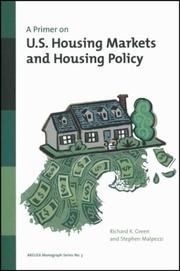| Listing 1 - 7 of 7 |
Sort by
|
Book
Year: 1995 Publisher: Cambridge, Mass. National Bureau of Economic Research
Abstract | Keywords | Export | Availability | Bookmark
 Loading...
Loading...Choose an application
- Reference Manager
- EndNote
- RefWorks (Direct export to RefWorks)
Book
Year: 1993 Publisher: Cambridge, Mass. National Bureau of Economic Research
Abstract | Keywords | Export | Availability | Bookmark
 Loading...
Loading...Choose an application
- Reference Manager
- EndNote
- RefWorks (Direct export to RefWorks)

ISBN: 0877667020 Year: 2003 Publisher: Washington (D.C.) Urban institute press
Abstract | Keywords | Export | Availability | Bookmark
 Loading...
Loading...Choose an application
- Reference Manager
- EndNote
- RefWorks (Direct export to RefWorks)
Housing policy --- Housing --- Prices
Book
Year: 1995 Publisher: Cambridge, Mass. National Bureau of Economic Research
Abstract | Keywords | Export | Availability | Bookmark
 Loading...
Loading...Choose an application
- Reference Manager
- EndNote
- RefWorks (Direct export to RefWorks)
The homeownership rate in the United States was essentially stagnant during the 1980's. This stagnation should be a source of concern if the rate reflects stagnant economic conditions and ownership opportunities, not if it simply reflects changing demographic conditions or preferences. Using a series of affordability measures, we find that homeownership opportunities improved almost everywhere during the 1980's, suggesting that the cause of the stagnant rate was something other than economic conditions. In fact, we find that both demographics and changes in preferences led to an increase in the proportion of households headed by single people; all else being equal, this would tend to push the owner-occupancy rate downward. We also found that while homeownership opportunities improved during the 1980's, the ex ante use cost of owning a home increased almost everywhere, reducing the financial attractiveness of owning a home. The combination of improving affordability conditions and worsening financial appeal had an overall neutral effect on the aggregate ownership rate.
Book
ISBN: 131768785X 1315775573 1317687841 Year: 2018 Publisher: Boca Raton, FL : Routledge,
Abstract | Keywords | Export | Availability | Bookmark
 Loading...
Loading...Choose an application
- Reference Manager
- EndNote
- RefWorks (Direct export to RefWorks)
Real estate represents an increasingly significant global asset class and its distinctive characteristics must be understood by investors and researchers. The Routledge Companion to Real Estate Investment provides an authoritative overview of the real estate asset class. The Companion focuses on the current academic research and its relevance for practical applications. The book is divided into four parts, each containing specially written chapters by international experts in the relevant field. The contributors cover the institutional context for real estate investment, the main players in real estate investment, real estate appraisal and performance measurement, and real estate portfolios and risk management. This Companion provides a comprehensive reference for students, academics and professionals studying, researching and working in real estate investment, finance and economics.
Book
Year: 1993 Publisher: Cambridge, Mass. National Bureau of Economic Research
Abstract | Keywords | Export | Availability | Bookmark
 Loading...
Loading...Choose an application
- Reference Manager
- EndNote
- RefWorks (Direct export to RefWorks)
Real house prices are directly determined by the willingness of households to pay for (and willingness of builders to supply) a constant-quality house. Changes in the quantity of housing demanded will affect real prices only to the extent that the long-run housing supply schedule is positively sloped. In this paper we use 1980 census data to measure the impact of the age structure and real income per household on the willingness of households to pay for a constant quality house. Extrapolating these variables forward to 2010, we conclude that evolving demographic forces are likely to raise real house prices. not lower them.
Book

ISBN: 9780292737938 Year: 2021 Publisher: Austin
Abstract | Keywords | Export | Availability | Bookmark
 Loading...
Loading...Choose an application
- Reference Manager
- EndNote
- RefWorks (Direct export to RefWorks)
| Listing 1 - 7 of 7 |
Sort by
|

 Search
Search Feedback
Feedback About
About Help
Help News
News